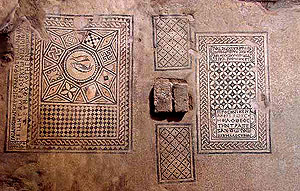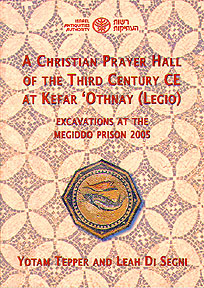Multimedia • Reference • Religion • Travel |
 A Christian Prayer Hall of the Third Century CE at Kefar `Othnay (Legio) Excavations at the Megiddo Prison 2005 Yotam Tepper and Leah Di Segni
Description From The Publisher: From 2003-2005 extensive archaeological salvage excavations were conducted inside the Megiddo Prison compound. An area of 3000 sq m was excavated inside the ancient Jewish village of Kefar `Othnay. A large residential building, dating from the third century CD, was exposed during the excavation of the settlement. Finds from this building indicate that is was used by soldiers of the Roman army and that one of the wings functioned as a prayer hall for a local Christian community. This discovery is of great importance as it dates to the period prior to the recognition of Christianity as an official religion. From Dr. James Tabor: In November, 2005 the news spread quickly around the world--oldest "church" ever found has been discovered near the biblical site of Armageddon! Now that the dust has cleared a bit, literally, the story of this most extraordinary archaeological find has just become available in an attractive, lavishly illustrated, full-color booklet published by the Israel Antiquities Authority titled, A Christian Prayer Hall of the 3rd Century. The authors, excavation director Yotam Tepper, and epigraphic expert Leah Di Segni have provided us with a fascinating but authoritative, account of the excavation and its significance narrated in an accessible style for the non-specialist. The site was uncovered on the grounds of a modern Israeli prison near Megiddo. It gives us a precious glimpse into early Christian worship and devotion before the time of Constantine when structures we can definitely identify as "Churches" began to predominate. What we appear to have here is what the authors have called a "Christian prayer hall." It is a room, complete with mosaics containing art work and inscriptions, dedicated to "the God Jesus Christ," with obvious ritual purposes in mind, but quite different from later Christian churches of the Byzantine period. The structure appears to date to the early 3rd century, making it by far the most important early Christian archaeological sites ever discovered. In the book, Tepper and Segni throughly explore the textual evidence from sources such as the Didache, that might shed light on our interpretation of this most fascinating find. They also discuss the potential significance of one of the three inscriptions that mentions four women, singled out as having special importance to the community. Scholars have only begun to probe the amazing significance of this precious find. This little book should be come a model for publications in the field of archaeology. It is beautifully done, reasonably priced, and as readable as it is informative. It is a must for anyone interested in the earliest archaeological records of the spread of Christianity in the Holy Land. James D. Tabor Chair, Dept. of Religious Studies Prof. of Ancient Judaism and Early Christianity University of North Carolina at Charlotte Reviews Reader's Index Send us your favorite quotes or passages from this book.  General view of the mocaic floor of the Christian prayer hall. About the Authors Table of Contents
Customer Reviews Write your own online review. Look for Similar Books by Subject | |||||||||||||||||||||||||||||||||||||||||||||||||||||||
Copyright ©1996-2003 CenturyOne Bookstore. All Rights Reserved. All prices subject to change and given in U.S. dollars. Your purchase from CenturyOne.com will assist the CenturyOne Foundation in providing funding for various archaeological and research projects which seek to provide more information about the period of the First Century C.E., the origins of Christianity and the world of the Bible in general. |

